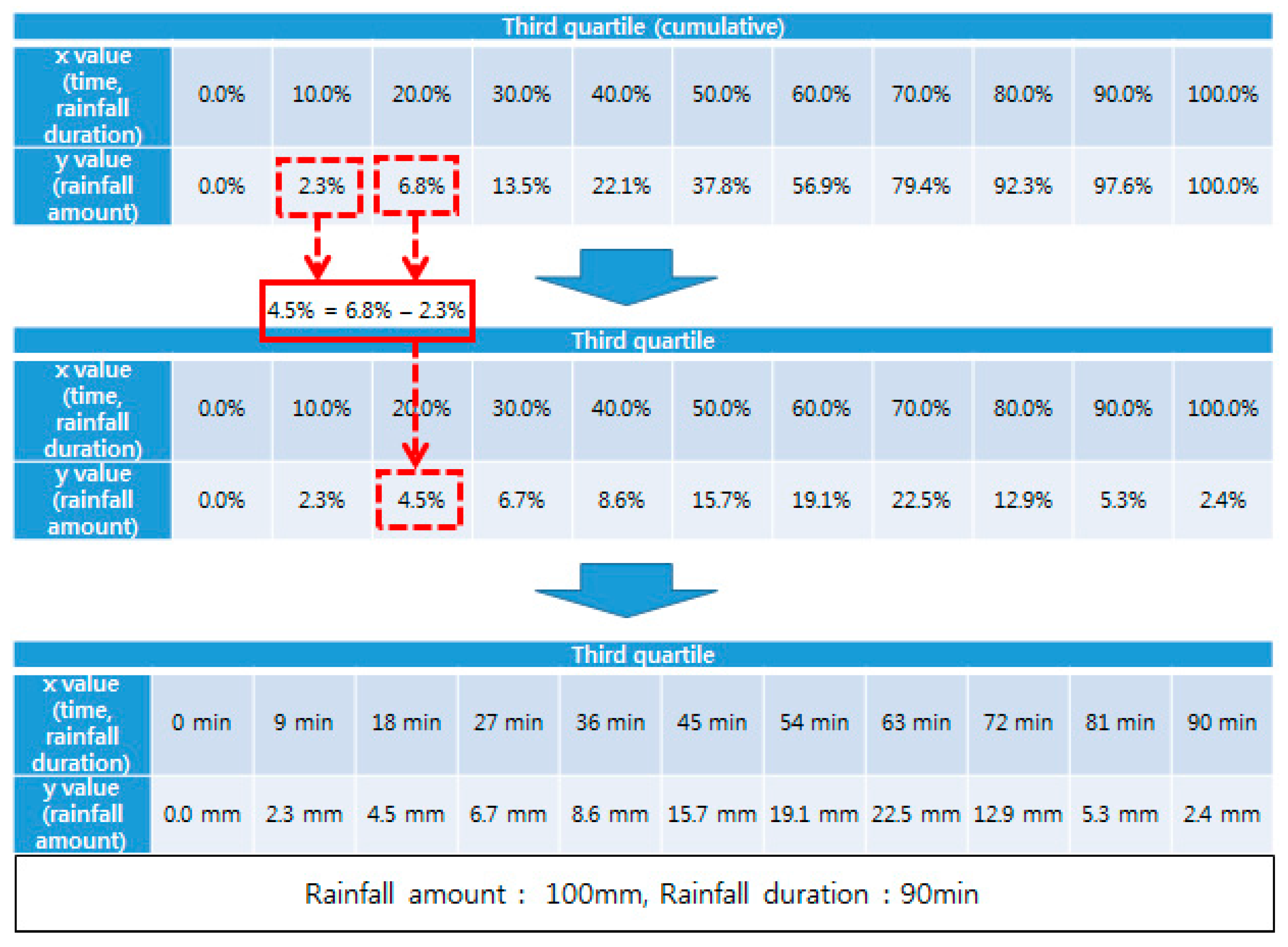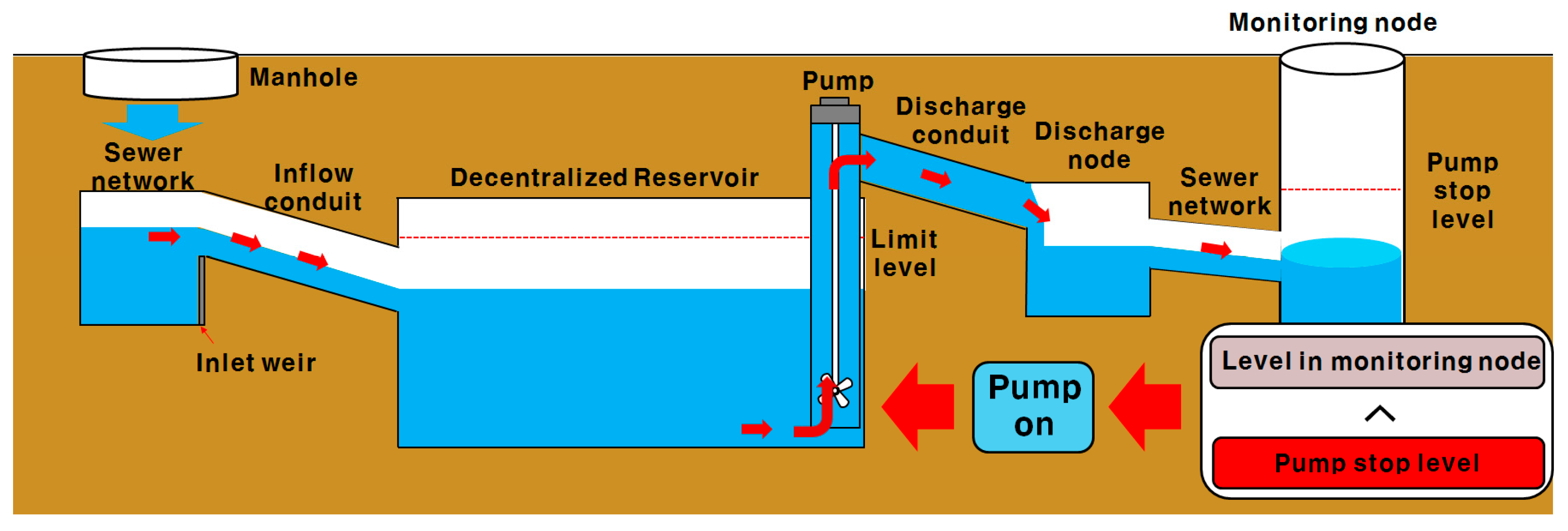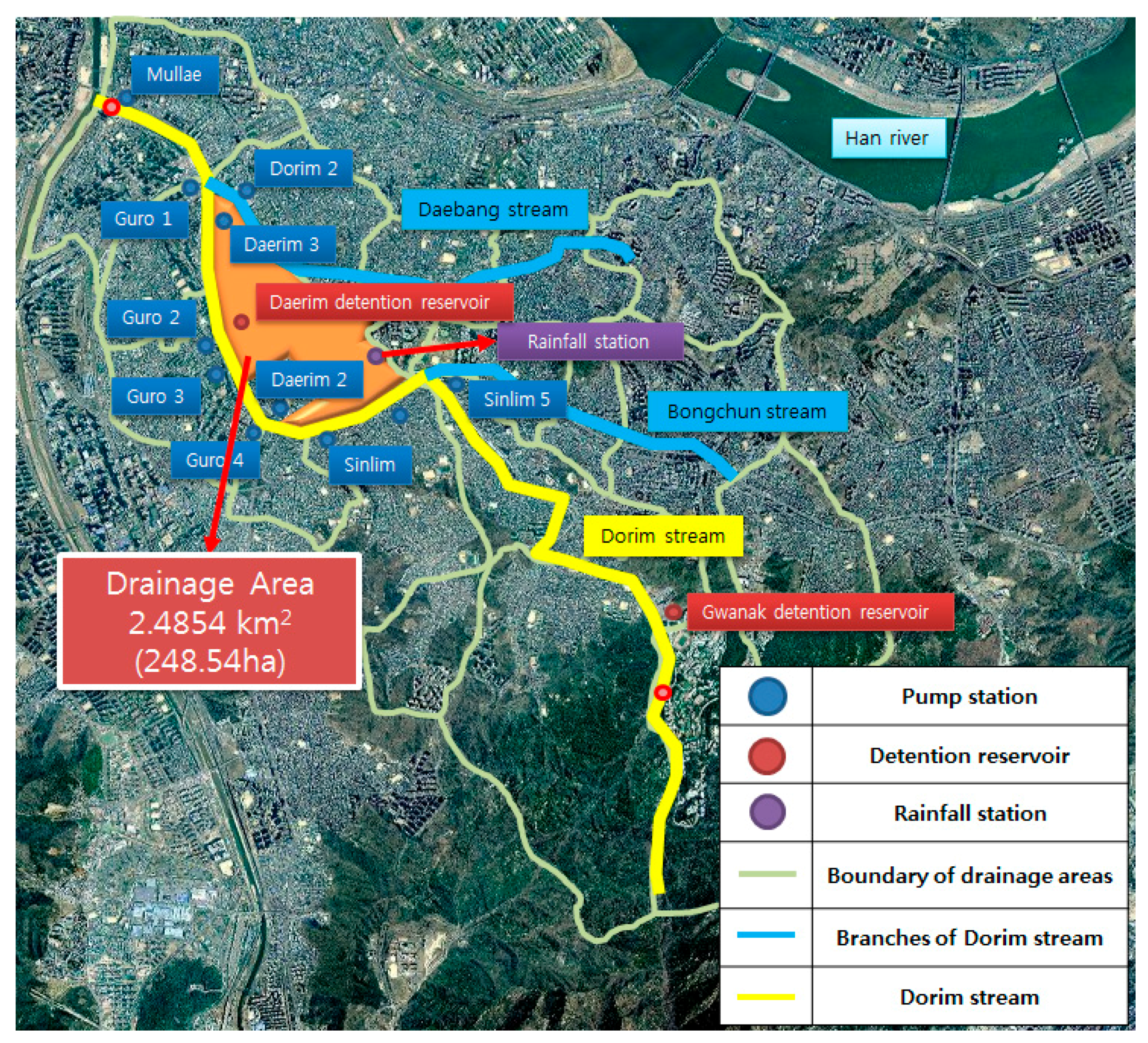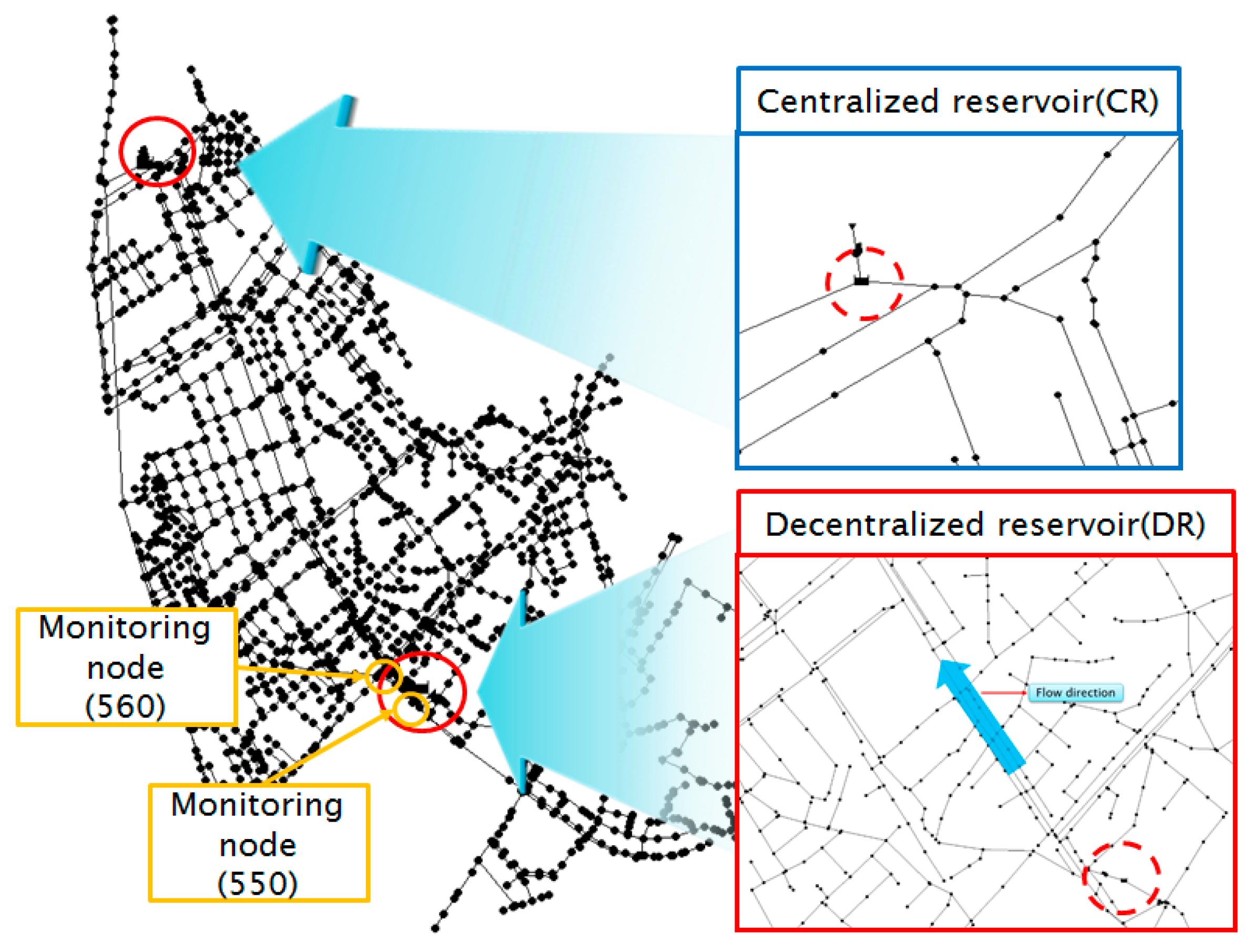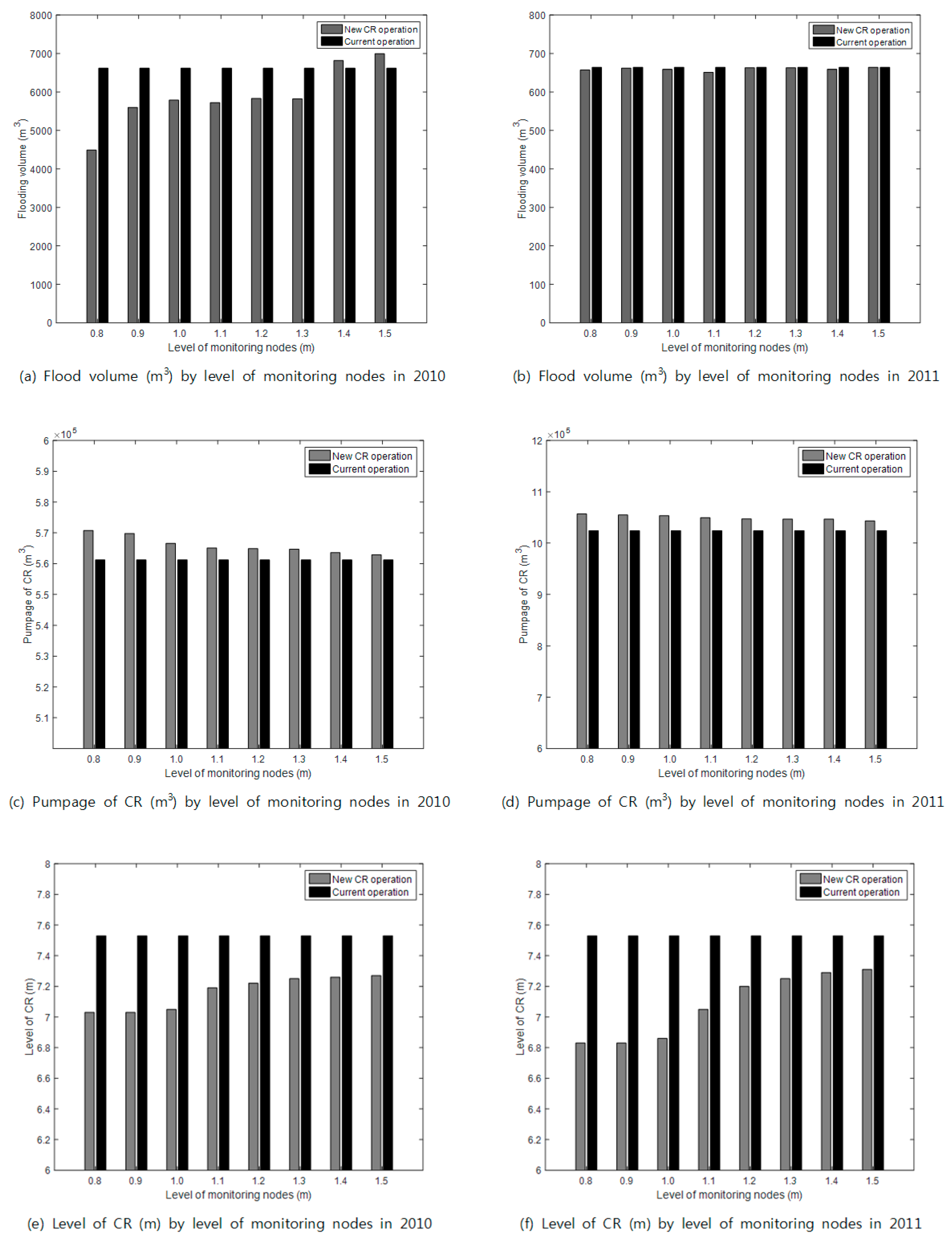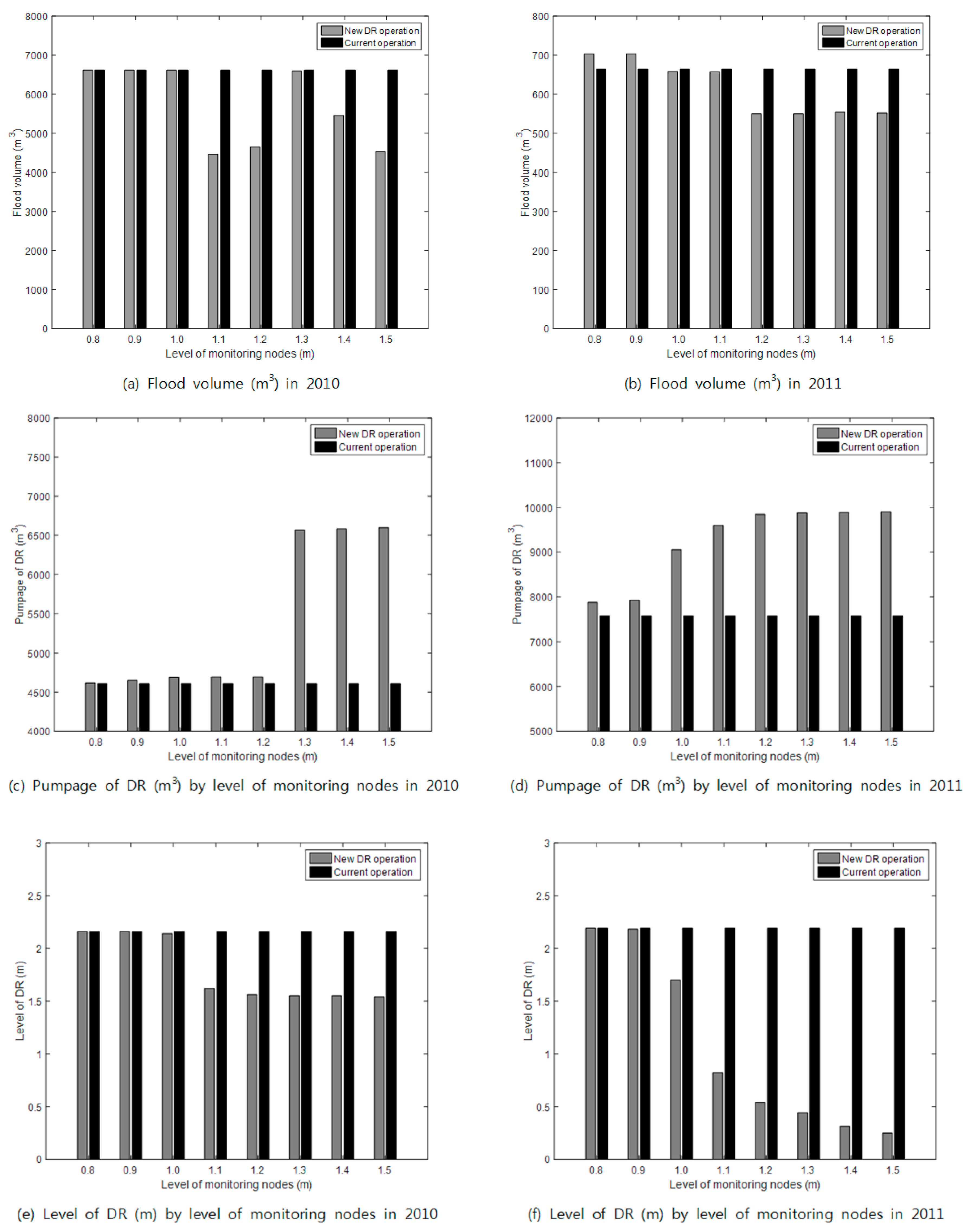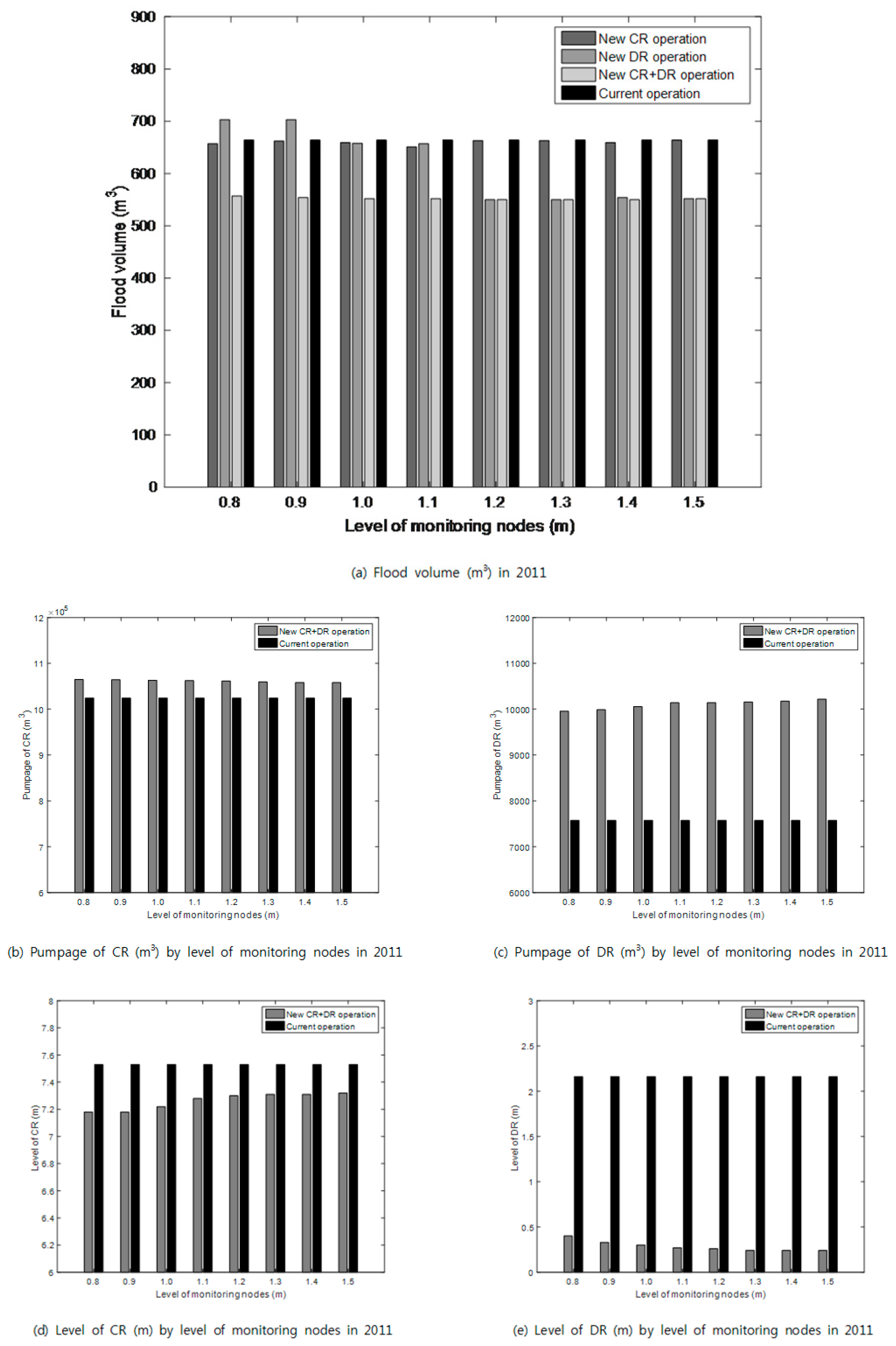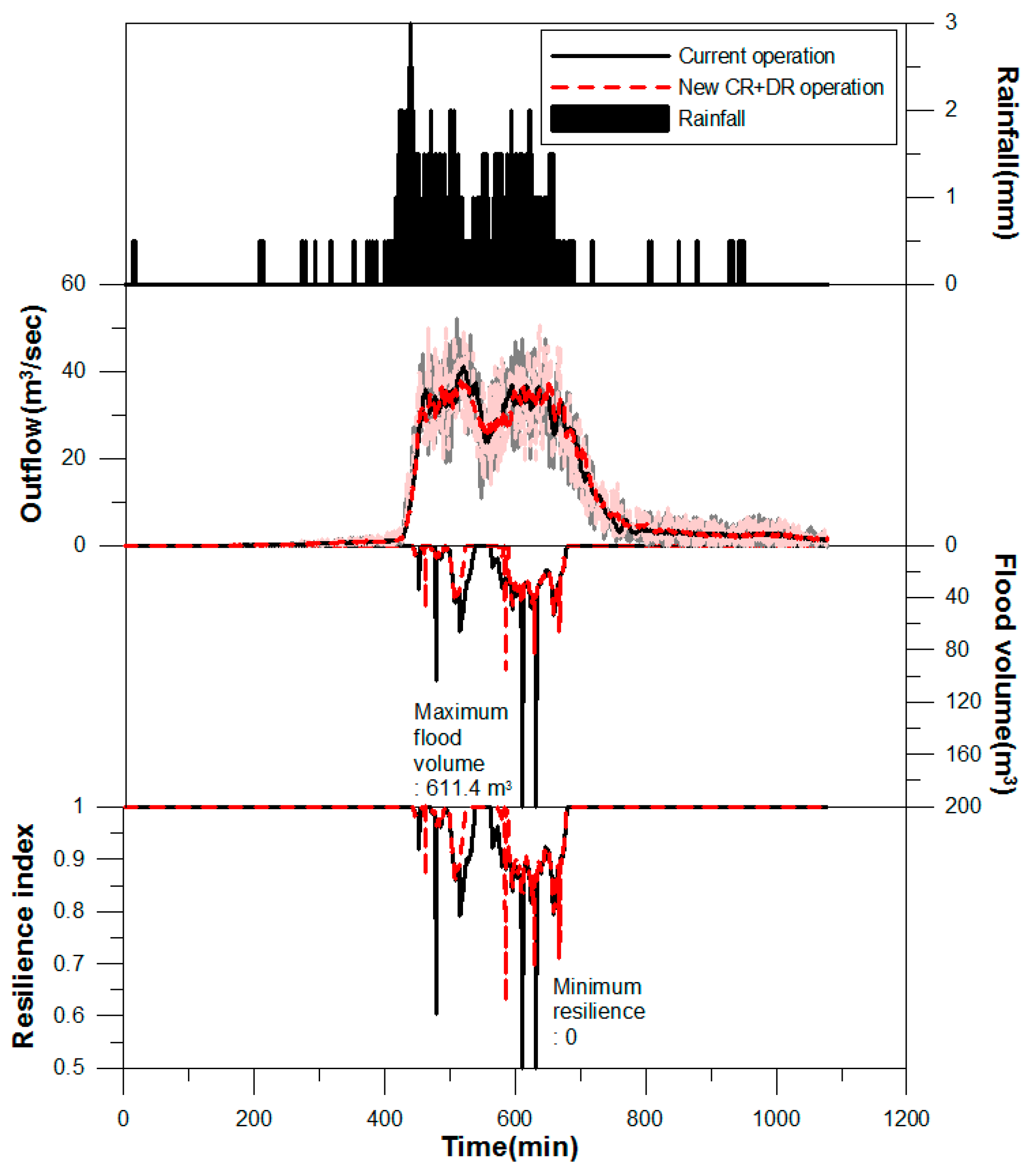3.1. Study Area
Seoul is one of the most urbanized cities in the world and consists of 25 administrative districts. The Han River flows through the center of Seoul. It has several tributaries, including Banpo stream, Wangsuk stream, Anyang stream, and Jungnang stream. In this study, we select Dorim stream as a target. Dorim stream runs through the Guro-gu, Yeongdeungpo-gu, and Gwank-gu administrative districts, and its tributaries include Daebang-cheon and Bongcheon-cheon.
As shown in
Figure 9, there are 10 pump stations, 2 detention reservoirs, and 2 tributaries in the Dorim stream basin. The basin above Daerim 3 pump station is selected for the application of cooperative operation, as proposed in this study. A detention reservoir is installed in the upstream drainage system connected to Daerim 3 pump station, which is located at the basin outlet. Since the DR was installed in 2009, there have been two episodes of flooding, in 2010 and 2011.
For this study, we select the largest events in the recent flood record in order to compare the different operating systems using disaster year books issued by the Ministry of Public Safety and Security [
22,
23,
24,
25,
26,
27], which contain information on disaster type, area, duration, statistical data, and typhoon trajectories.
Table 1 lists rainfall periods from 2008 to 2014, as identified in the disaster year books [
22,
23,
24,
25,
26,
27]. The target basin was damaged in significant events on 23 September 2010 and 27 July 2011. Rainfall duration and frequency, respectively, is estimated as 240 min and 100 years for the 2010 event, and 1080 min and 100 years for the 2011 event.
The design return period for the Daerim 3 pump station is 30 years. A total of 12 drainage pumps (1 pump at 300 kW, 7 at 413 kW, 2 at 450 kW, and 2 at 900 kW) are installed, with a total discharge capacity of 57.02 m
3/s. The CR has a total capacity of 33,650 m
3, a HWL at 9.0 m, and a LWL at 6.8 m. The first drainage pump at the CR is operated at the initial operating level and all drainage pumps at the CR are operated at all operating level. The time of concentration in the Daerim 3 pump station basin is 30 min [
28].
The detention reservoirs in the Daerim basin have a design return period of 20 years. The 5-year-flow is designed to go over the weir and into the reservoir. The weir has a width of 2 m and a height of 0.4 m, and is located on the right side of a rectangular type sewer 2 m wide and 1.5 m high. As a result, the detention reservoir has a total height of 3.2 m, a freeboard of 1 m, and a total detention volume of 2447 m
3. It is impossible for the Daerim detention reservoirs to drain naturally; however, they can also drain by operation of a submersible pump at 22 kW, which has a capacity of 9.0 m
3/min with a total head of 6.0 m [
29].
The model is manually calibrated. We focus on four aims when calibrating the model: matching the peak discharge and peak time total runoff volume, and minimizing the Root Mean Square Error (RMSE) between the observed inflow data and the simulated inflow results for 2010 and 2011. First, rainfall data for 21 September 2010 and 27 July 2011 are used for calibration of the rainfall-runoff model. Inflow is estimated using pump operation records and the variance of CR level because CR in the pump station does not measure inflow.
Figure 10 describes the observed/simulated inflow hydrograph in the target basin and the accuracy of calibration/validation.
Table 2 shows the types and values of the calibrated parameters in SWMM. For calibration and validation of the target basin, three parameters are used: percentage of the impervious area, width of the subcatchment, and percentage of slopes in the subcatchment. The total number of parameters is 4728 because the total number of subcatchments is 1576. In this study, Manning’s roughness coefficient in the conduits is assumed to be uniformly 0.014 following a technical report written after the recent rehabilitation and maintenance of the Daerim 3 pump station and the design of the Daerim detention reservoir.
The “control” module in EPA-SWMM is used for various simulations of CR and DR operations. It is a simple code whereby, for example “If node DB-1 depth ≥ 2.33 then pump ps1 status = on”. On the basis of GIS data, we construct and simulate sewage networks in Seoul, including the Daerim detention reservoir (
Figure 11).
3.2. Selection of Monitoring Nodes for Cooperative Operation of Urban Drainage Facilities
Monitoring nodes are selected on the basis of rainfall probability based on the third quartile of the Huff distribution, as proposed by Yoon et al. Different quartiles of the Huff distributions have different peak locations, and in the case of the third quartile, the peak tends to be in the latter half of the event. We use two methods to select monitoring nodes, based on first and maximum flooding. First, we select three rainfall durations (30, 60, and 90 min) for simulation of the first flooding node, up to three times as long as the time of concentration in the target basin (30 min). For each rainfall duration, we increase total rainfall volume in 1 mm increments until the first flooding occurs, and identify the first flooding node. Sewer conduits in urban areas can be divided into main and branch conduits according to the associated basin area runoff coefficient (C) and drainage area (A). The first flooding generally occurred at branch conduits for which design frequency (CA < 0.12 km2) is only 5–10 years (that of the main conduit is 30 years) and thus the conditions of the whole basin cannot be effectively determined by only considering the branch conduits. Therefore, we increase total rainfall volume until the first flooding occurs in the main conduits (CA ≥ 0.12 km2).
To identify the maximum flooding node, we review a total of nine conditions of rainfall probability frequency and duration (a combination of 30, 50, and 100 year frequencies, and 30, 60, and 90 min durations) in the Huff third quartile distribution. However, the maximum flooding nodes identified in this process are not consistent across all nine conditions, except at Daerim reservoir, and are located in branch conduits making it problematic to use them as monitoring nodes. The maximum flooding nodes that are located in main conduits are all at location 550. Thus, we review maximum flooding nodes on the basis of rainfall on 23 September 2010 and 27 July 2011. The maximum flooding node occurred in the Daerim detention reservoir. However, as the interior level of the detention reservoir is considered in the current operation of drainage facilities, we only count nodes in the main conduits. Therefore, the highest flood volume in both events is observed at location 550. Details of the selected monitoring nodes are shown in
Table 3. We select locations 560 and 550, the first and maximum flooding nodes, respectively, as the monitoring nodes for operation of the CR, DR, and cooperative CR/DR. The nodes at 560 and 550 are located within the 2-line main conduits with a height of 1.5 m and width of 2 m.
3.3. Operation of CR Based on Monitoring Node Levels
The CR is operated as follows. When stream level is lower than the base of the drainage gate, water in the CR naturally drains through the drainage gate. When stream level is higher than the base of the drainage gate, the gate is closed and water is forced to drain using drainage pumps. When no water enters the CR, drainage pump operation is stopped.
As previously mentioned, drainage pumps in the pump station are activated according to the level of the CR. High CR water levels increase the water level in conduits of the upstream drainage system, resulting in a backwater effect. Low CR water levels decrease the level of upstream sewer conduits. Initial early operating levels for preventing cavitation in the Daerim 3 pump station are calculated using the following procedure. The initial early operating level is calculated as the sum of the required depth (A), the screen head loss (B), and the freeboard for mechanical operation (C). The entire calculation procedure for the initial operating level in the new operation shown in
Table 4 is explained below.
The required depth is the minimum depth for the pump operating cycle (A), calculated by dividing the required volume in CR (A1) by the average area in CR (A2). The required volume in CR (A1) is calculated by multiplying the initial pump discharge (3.88 m3/s = 233 m3/min) and the preparation time (30 min), and dividing by four. The required volume in CR (A1) is 1711 m3. The required depth (A, 0.15 m) is the value of the required volume in CR (A1, 1711 m3) divided by the average area in CR (A2, 11,400 m2).
Screen head loss (B) refers to the variance of the level in the collecting well of CR when the initial pump is operated. It generally has a value between 0.1 m and 0.3 m. In this study, 0.1 m is selected as the screen head loss (B). The freeboard for mechanical operation (C) is the freeboard used for mechanical work such as valve opening and pump operation when an initial pump is operated. It is generally from 0.0 m to 0.2 m. In this study, 0.05 m is the freeboard for mechanical operation (C). The last calculation for initial operating depth in the new drainage system operation is the sum (0.3 m) of the required depth (A, 0.15 m), (B, 0.1 m), and (C, 0.05 m), which is added to the elevation in the bed of the CR (6.5 m). The initial operating elevation is set at 6.8 m.
Determination of the initial operating level is complicated because it is closely related to cavitation of the initial operating pump. Excluding calculation of the initial operating level, calculation of the other operating levels is based on the required depth (A). At low elevation, between 6.5 m and 7.3 m, the operating interval is larger than at high elevation because preparation time of longer than 10 min is required. Additionally, we follow the order of pump discharge in the current operation because the order of pump discharge at each pump station is already fixed by the local government. It is determined by considering the pump rotation cycle for maintenance control of the pumps.
We set the pump discharge level at the monitoring node to 0.5 D (about 0.8 m), where D is total height, increasing to 1.0 D (1.5 m) in increments of 0.1 D, and simulate rainfall-runoff processes and pump operation independently for each case, in order to obtain flood volume. When the monitoring node level is below 0.5 D, the flood volume results are the same as for 0.5 D because reducing the level in CR (reducing the backwater effect) is not related to reducing flooding when the monitoring node level is low. We assess the results by applying rainfall from the two events of 23 September 2010 and 27 July 2011 (
Figure 12).
For the 2010 event, the new CR operation resulted in lower flood volume than with the current operation, except at high monitoring node levels (1.4 m–1.5 m) (
Figure 12a). Anomalous results at 1.4 m and 1.5 m by CR operation are based on current DR operation. Higher flood volumes than the current operation can be achieved if pumps are operated when monitoring node levels are high because pumps are operated according to DR levels in the current DR operation. For the 2011 event, all flood volumes were lower than those of the current CR operation (
Figure 12b) because the CR level was low due to early operation of pumps, and the level decreased in upstream nodes, including flooding nodes.
Figure 12b also shows that the largest flood volumes occur in the high and low monitoring node levels, but the smallest flood volumes occur in the medium monitoring node levels.
Figure 12c,d show the pumpage of CR at the time corresponding to the level of monitoring nodes in 2010 and 2011, respectively, and
Figure 12e,f show the level of CR in 2010 and 2011, respectively. The results of the new CR operation were compared to that of the current operation. It was confirmed that the pumpage of CR decreases (
Figure 12c,d) and the level of CR increases (
Figure 12e,f) as the level of monitoring nodes increases. Therefore, total flooding volume is affected by the pumpage of CR triggered by the level of monitoring nodes under the new CR operation in which proactive pumping for the reduction of the backwater effect is capable. On the other hand, the pumpage and level of CR under the current operation do not affected by the level of monitoring nodes.
Flood volume is small if there is enough storage space in DR when the level in the sewer conduits is high. Flood volume is large if there is scant storage space in DR when the level in the sewer conduits is high. However, the CR operation results vary depending on monitoring node levels due to the impact of DR operation; current DR operation is used to compare the current and new CR operations. Current operation of the DR is not related to the level of the sewer conduits, but depends on the interior level of the DR. Thus, if DR discharge coincides with the peak level in the sewer conduits, it augments the flood volume.
Flood volume patterns corresponding to various monitoring node levels for the 2010 and 2011 events differ in
Figure 12. Flood volume in the new CR operation is higher than the current operation despite the low level of CR when the level of monitoring nodes are high. It is based on the capacity limitation of CR. There are irregular flooding patterns because the frequency of 2010 and 2011 rainfall events are over 100 years though the design frequency of CR is 30 years. Additionally, it is due to the locations of peak rainfall events and the CR level at the time of the peak rainfall events.
3.4. Operation of DR Based on Monitoring Node Levels
Current operation of the DR is performed as follows. Inflow from sewer conduits enters through the inlet weir. If it is not possible to drain naturally, drainage pumps are used in the detention reservoir. DR operation is controlled by discharge conditions. Discharge from the DR starts when the interior level reaches the limit level, or when the rainfall is determined to have ended. The DRs in urban areas are generally installed to make up for the lack of water delivery capacity in the sewer conduits. Even with low intensity rainfall, water overtops the weir of the inflow conduit, and storage in the DR is initiated. However, if rainfall continues, the DR is already full after the low intensity rainfall and cannot take additional water from the sewer conduits.
In this section, the new operation is applied to determine DR discharge depending on monitoring node levels (
Figure 13). For the 2010 event, results of the new DR operation are improved compared to those of the current CR operation (
Figure 13a).
Figure 14a also shows that the largest flood volume occurs in high and low monitoring node levels, but the smallest flood volume occurs in medium monitoring node levels, both for the same reason as for the results shown in
Figure 12b. Flood volume is small if there is enough storage space in the DR when the level in the sewer conduits is high, and flood volume is large if there is scant storage space in the DR when the level in the sewer conduits is high. For the 2011 event, results at monitoring nodes with levels of more than 0.9 m are better than those of the current operation, but those for the 0.8 m and 0.9 m levels are inferior because pump discharge in the new operation is smaller than pump discharge in the current operation when discharge is ceased at low monitoring node levels. This means that the new operation obtains a smaller additional DR capacity than the current operation at low pump stop levels. The variation in new DR operation results with monitoring node level is due to the design capacity of the DR. Rainfall associated with the 2010 and 2011 events has a maximum return period of up to 100 years, while DR design capacity is only 20 years. Thus, it is difficult to prevent widespread flooding and the operational effects are inconsistent.
Figure 13c,d show the pumpage of DR at the time corresponding to the level of monitoring nodes in 2010 and 2011, respectively, and
Figure 13e,f show the level of DR in 2010 and 2011, respectively. The pumpage of DR was significantly increased (
Figure 13c,d) and the level of DR were dramatically decreased (
Figure 13e,f) if the level of monitoring nodes is higher than or equal to 1.1 m which is identified as the critical level for flooding. The consequence of such operation is low flooding volume (
Figure 13a,b).
3.5. Cooperative Operation of Urban Drainage Facilities
Various urban drainage facilities are operated in each area, often regardless of the sewer conduit conditions, and independent of other urban drainage facilities. However, other drainage facilities within the same drainage area should be considered in order to meet the goal of urban area drainage.
For proper operation of urban drainage facilities, including the CRs and DRs installed in urban areas, it is necessary to prevent flooding, because a lack of capacity increases the flood risk in the drainage system. However, when rainfall is continuous, it is necessary to efficiently share the flood volume across urban drainage facilities. In this section, cooperative operation of the CR and DR is applied at the monitoring nodes, and the results are shown in
Figure 14 and
Figure 15. For both 2010 and 2011, results of cooperative operation are superior to those of the current operation because CR/DR cooperative operation results in a smaller flood volume than all monitoring node levels of the current operation for 2010 and 2011 (
Figure 14a and
Figure 15a, respectively). This is due to the detention effectiveness of DR operation and the rapid drainage effectiveness of CR. However, the same variability as the CR and DR operations is observed across the monitoring node levels, due to the way the DR operation is included.
The pumpage of CR and DR and their level under the cooperative operation were compared to those under the current operation.
Figure 14b,c show the pumpage of CR and DR, respectively, with respect to the level of monitoring nodes under two operations in 2010.
Figure 14d,e show the level of CR and DR in 2010, respectively.
Figure 15b,c show the pumpage of CR and DR in 2011, respectively, and
Figure 15d,e show the level of CR and DR in 2011, respectively. Regardless of the year of rainfall event, overall pumpage of CR and DR is higher than that of the current operation (
Figure 14b,c and
Figure 15b,c) and the level of CR and DR is lower than that of the current operation (
Figure 14d,e and
Figure 15d,e). The pumpage and level of CR and DR in both events show similar patterns (as seen in
Figure 12 and
Figure 13, although attenuated increase and decrease were observed for the pumpage and level of DR, respectively (
Figure 13c–f)). The notable point is that the CR/DR cooperative operation results in high pumpage and low level of CR and DR at all levels of monitoring nodes, compared to the current operation. As we confirmed from the previous two cases (the new CR operation and the new DR operation), it is originated from rapid drainage of CR and detention effectiveness of DR.
3.6. Evaluation of Urban Drainage System Resilience
Results of resilience evaluations for each operation method are shown in
Table 5. We assess resilience at a monitoring node level of 1.1 m for each operation using the 2010 and 2011 rainfall event. It is found that the resilience of the urban drainage system increases in each new operation compared to the current. The highest resilience is obtained under cooperative operation (CR + DR in
Table 5).
The results of system resilience vary with different monitoring node level, as shown as
Figure 16. In the results of 2010, CR operation shows somewhat less resilience than the current operation, though the DR operation shows better resilience than the current operation. When the monitoring node level is 1.1 m, all operations, including CR operation, DR operation, and CR/DR cooperative operation, show better resilience than the current operation.
The irregular patterns related to the monitoring node levels for both 2010 and 2011 are due to the discharge conditions in the DR. Discharge is conducted when the DR level reaches the limit level. The current DR operation and the DR operation in this study include this condition. Furthermore, there are several conduits with a reverse slope in the target basin. Generally, almost all sewer conduits have a slope because flow is induced by gravity; however, the design is a kind of inverted siphon due to the presence of a variety of obstacles, including Internet cables. This can result in irregular flow in the sewer network and therefore irregular patterns of system resilience.
In the results of 2011, individual operations, including CR operation and DR operation, show better results than the current operation in some parts and worse results in other parts, although CR/DR cooperative operation always shows better results than the current operation. The inferior resilience of individual CR and DR operation compared to historical operation is related to the current operation of DR and the available storage capacity in DR during the peak rainfall period. Current DR operation in CR operation starts to discharge based on the DR level, without considering the monitoring node levels. If current DR operation in individual CR operation starts to discharge pumps when monitoring node levels are high, the flood risk will be higher than for both current and cooperative operation, and system resilience will be lower than both current and cooperative operation.
Additionally, individual DR operation is inferior to the current operation in 2011 when the monitoring node levels are 0.8 m and 0.9 m. In DR operation, the DR reserves water if the monitoring node levels are high, though the DR operates the drainage pumps in the current operation when the DR level reaches the limit level. DR operation can show higher flood volumes than the current operation if the peak rainfall period occurs when the monitoring node levels are high, and the DR reserves water in DR operation. The system resilience of DR operation can be lower than both current and cooperative operation because of the available DR storage capacity when during the peak rainfall period. Furthermore, the individual operation of CR and DR over 30 and 20 years, respectively, is insufficient because the maximum return periods for 2010 and 2011 rainfall events are as long as 100 years. Therefore, it is difficult to overcome the drawbacks related to shortages in design size in individual CR and DR operation. For the 2010 rainfall event, the minimum increase for CR/DR cooperative operation compared with the current operation is 0.001612, and the maximum increase is 0.006716. For the 2011 rainfall event, the minimum increase is 0.000177 and the maximum increase 0.000194.
Figure 17 shows variations in rainfall, runoff, flood volume, and resilience over time for the 2010 event. Rainfall and runoff volume has two peaks, at 450 min and 650 min, respectively. Peak runoff volume in the CR, DR, and CR + DR operations is very similar, but is slightly higher under the current operation. Patterns of flood volume over time are similar to those of the resilience index. Considering the differences between the current and new operation in terms of rainfall and runoff relationships, the flood volumes associated with the first rainfall peak are not substantially different, but there is a significant difference associated with the second rainfall peak because the flood volume and resilience index differ greatly between the current operation and the CR/DR cooperative operation. The flood volume at the 650 min peak is 611.4 m
3 in the current operation but 100 m
3 in the CR/DR cooperative operation, which is the greatest difference for the whole period. The resilience index in the current operation is 0, but the resilience index in the CD/DR cooperative operation is 0.65. One of the reasons for the good results of the cooperative operation is due to draining the CR prior to subsequent storms, which reduces the CR level and mitigates the backwater effects of the CR.
